Cilantro is my favorite feral plant in the yard. It pops up in pathways, under fruit trees, over by the fence. And I do still plant some in my garden beds.
Yearly routine
I haven’t bought cilantro seed or plants for years because I’ve got a routine that keeps the cycle running with very little effort on my part. It starts with the first rains in fall. That’s when cilantro seed throughout the yard germinates.
Up pop the lime green cotyledons, and then the ferny true leaves. The winter rains sustain the plants. Even in dry years, I’ve never had to water them — they really do grow like they’re wild.
Through winter we eat the cilantro until late winter when the oldest plants start to bolt.
Or do they flower? Bolt has a negative connotation: it’s what lettuce does before you feel like you’ve gotten enough harvests out of the plant. But I should say that cilantro flowers because I grow it for its flowers as much as for its delicious leaves. Cilantro flowers feed bees and other pollinating and beneficial insects, such as syrphid flies.
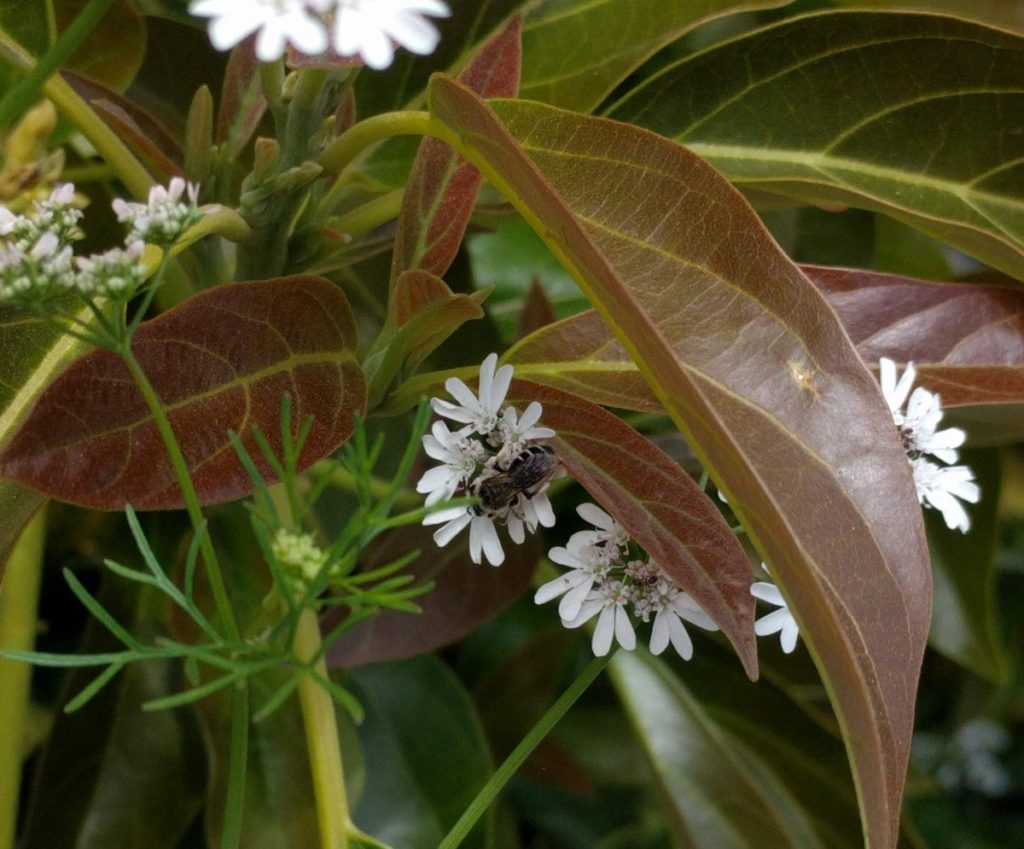
The flowers turn into seed in late spring, and I let much of the seed fall to the ground below the mother plants. That way I don’t have to plant again next year.
I also collect some of the seed in order to start new patches of cilantro elsewhere. That’s how cilantro seed has found its way throughout the yard.
The next fall rains arrive, and the cycle starts again.
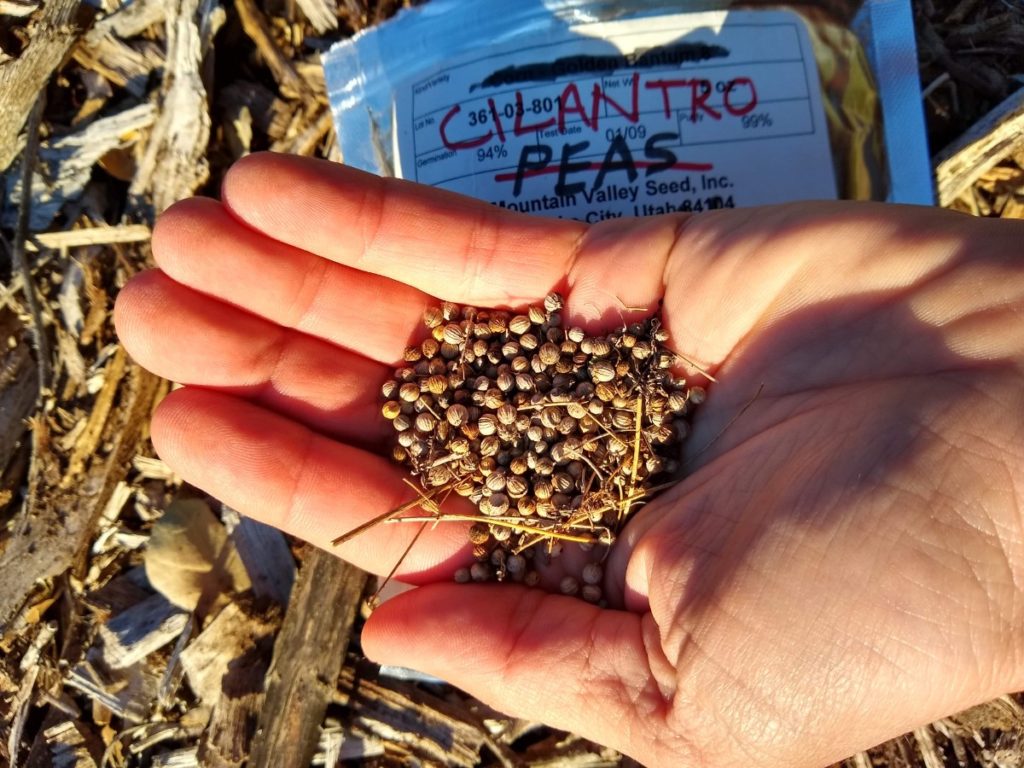
Sowing and planting cilantro
It is now early February, and I’ve still got some cilantro seed on hand. I like to keep some seed around so I can continue sowing new cilantro into the spring, maybe even summer, so I can eat it further into the warm part of the year, after the plants that grew naturally during winter have gone to flower.
A single cilantro plant grows to about a foot in diameter (then wider once it flowers), so you can set plants or sow seeds about that far apart. However, I often grow them more closely; they seem to like the company.
By the way, I have often heard or read this type of advice: “Cilantro is taprooted and transplants poorly, so start from seed.” That’s what the Sunset Western Garden Book says, but I find it to be only half true. Yes, cilantro has a taproot, but I’ve transplanted many cilantro seedlings over the years just fine. So I say, start them from seed or transplant them as seedlings, whichever you prefer. Both work.
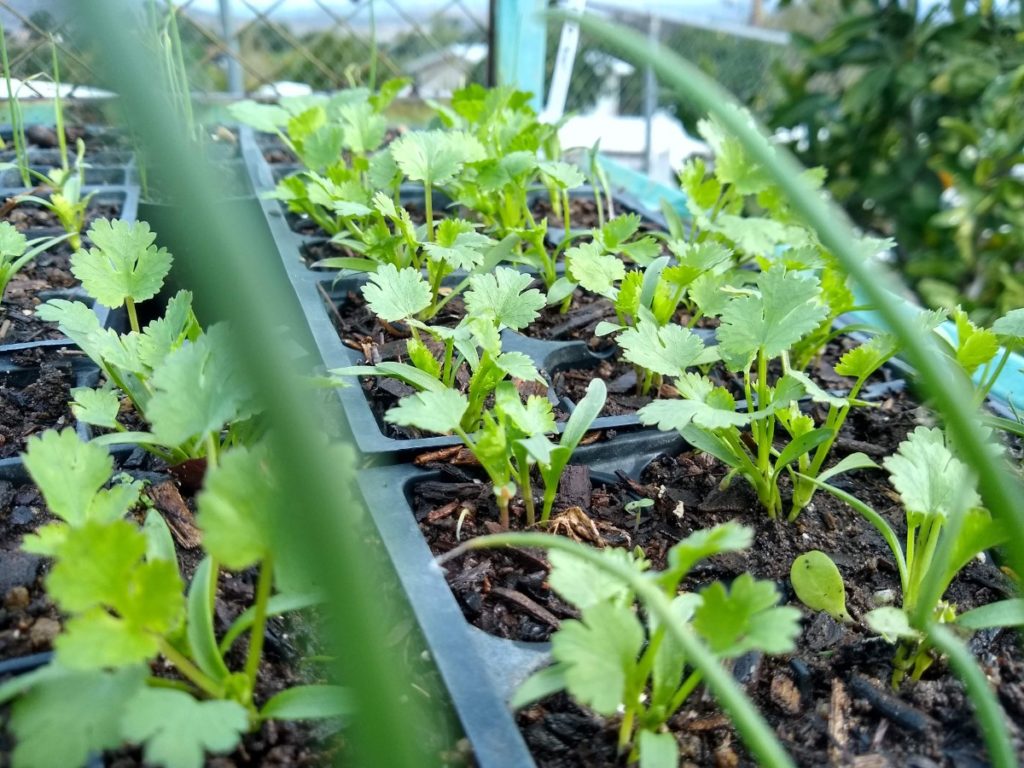
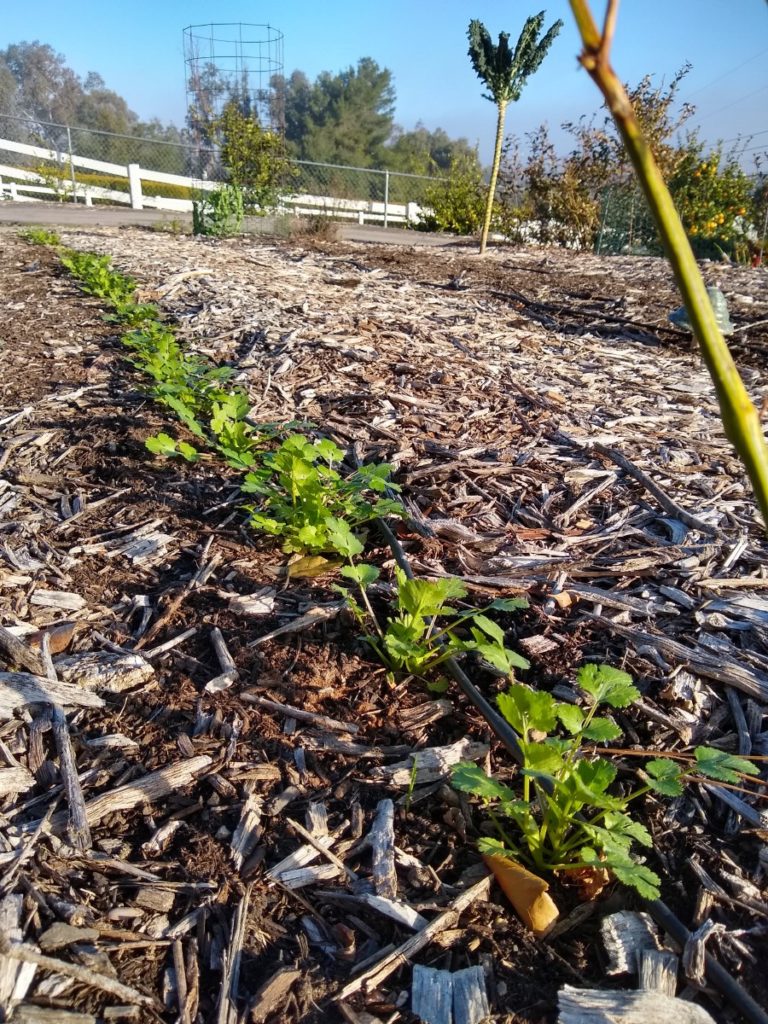
Cilantro doesn’t like summer. This has always struck me as strange because I use most of my cilantro in salsa, and all of the other salsa ingredients are ready to eat in summer: tomatoes, peppers, onions, garlic, lemons or limes. But cilantro is naturally a winter herb here in Southern California.
You can force cilantro to grow during warm weather though. It will grow in heat, briefly, until it shoots up a flower stalk, trying to finish its life as fast as possible. I’ve found that placing 30-percent shade cloth over cilantro plants in summer delays the bolting somewhat.
Bolting and flowering
I’ve heard it advised to cut the flower stalk in order to get more leafy growth out of a cilantro plant, but that’s never worked for me. Once a cilantro plant decides it’s time to stop only making leaves and start making flowers, it seems insistent on making flowers. In my experience, cutting the flower stalk only causes it to restart growing its flower stalk, not to revert to leaf production again.
You’ll find varieties of cilantro that claim to be “slow bolting,” but I’ve never found such varieties to be significantly slower to bolt than varieties that don’t make that claim.
The best way to be sure to get an extended harvest of cilantro is to sow or plant successively, that is, sow or plant new cilantro seeds or seedlings every few weeks or so.
And once the cilantro plants flower, enjoy this very useful stage of their lives. For one, a flowering cilantro plant is pretty, a bush of tiny white flowers.
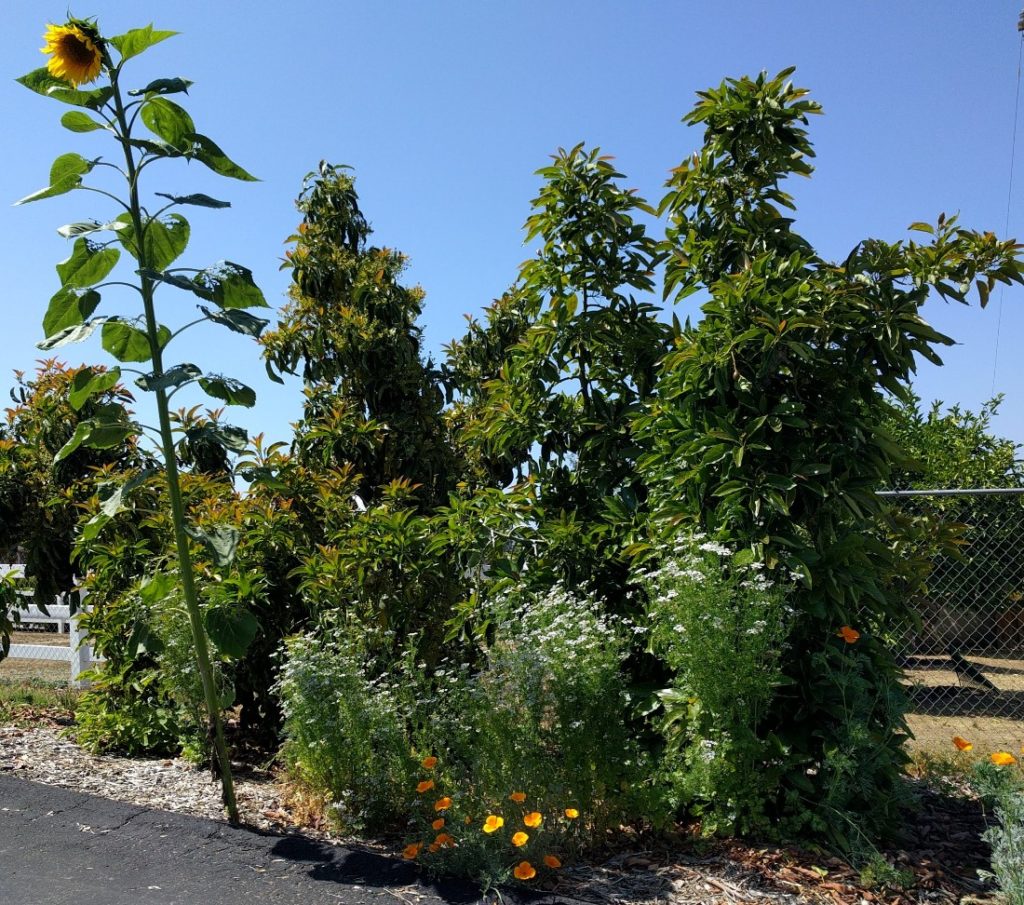
And secondly, bees and other insects love cilantro flowers and their pink pollen. Did you know that the pollen of cilantro flowers is pink? I first learned this from Gordon Frankie, of UC Berkeley’s Urban Bee Lab, and after learning so I’ve had fun trying to observe the collections of pink pollen on the legs of honeybees and native bees who visit cilantro flowers.
Harvesting
I usually harvest cilantro by pinching stems just below their lowest sets of leaves. You can also harvest cilantro with scissors. In fact, you can cut all the leaves off a cilantro plant almost to the ground and the plant will grow back since the crown of a cilantro plant (where new leaves emerge) is almost at ground level. Cilantro is like lettuce in this respect.
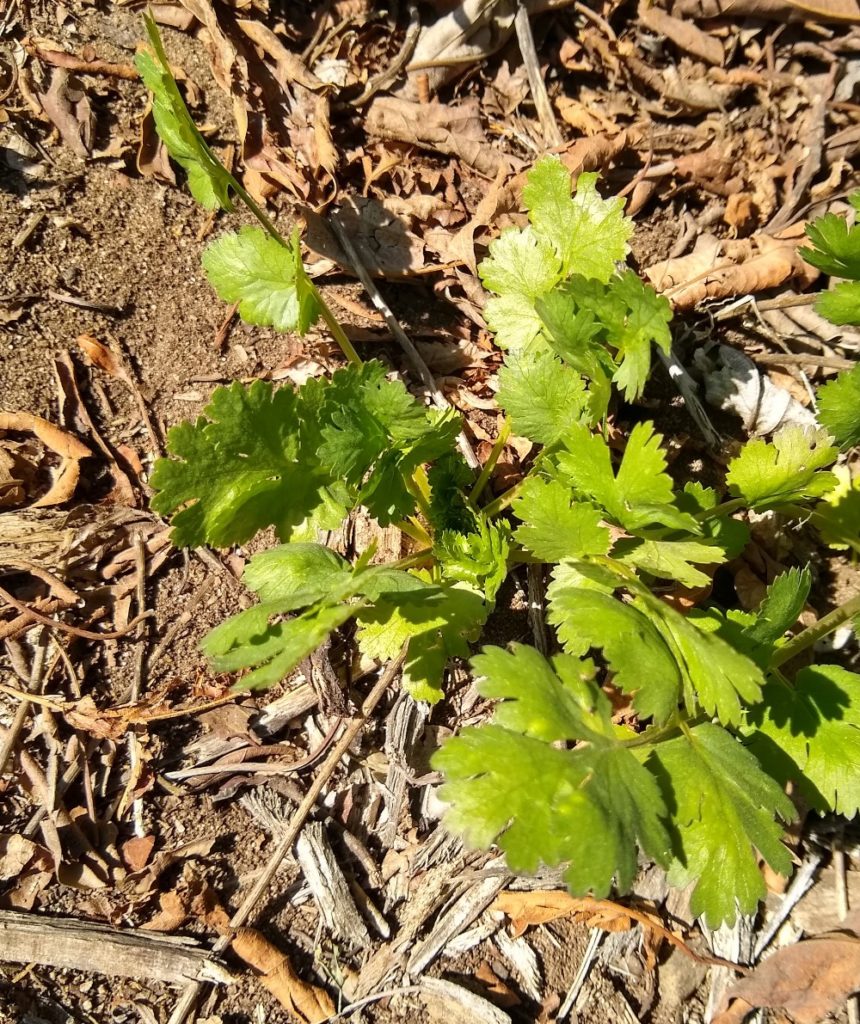
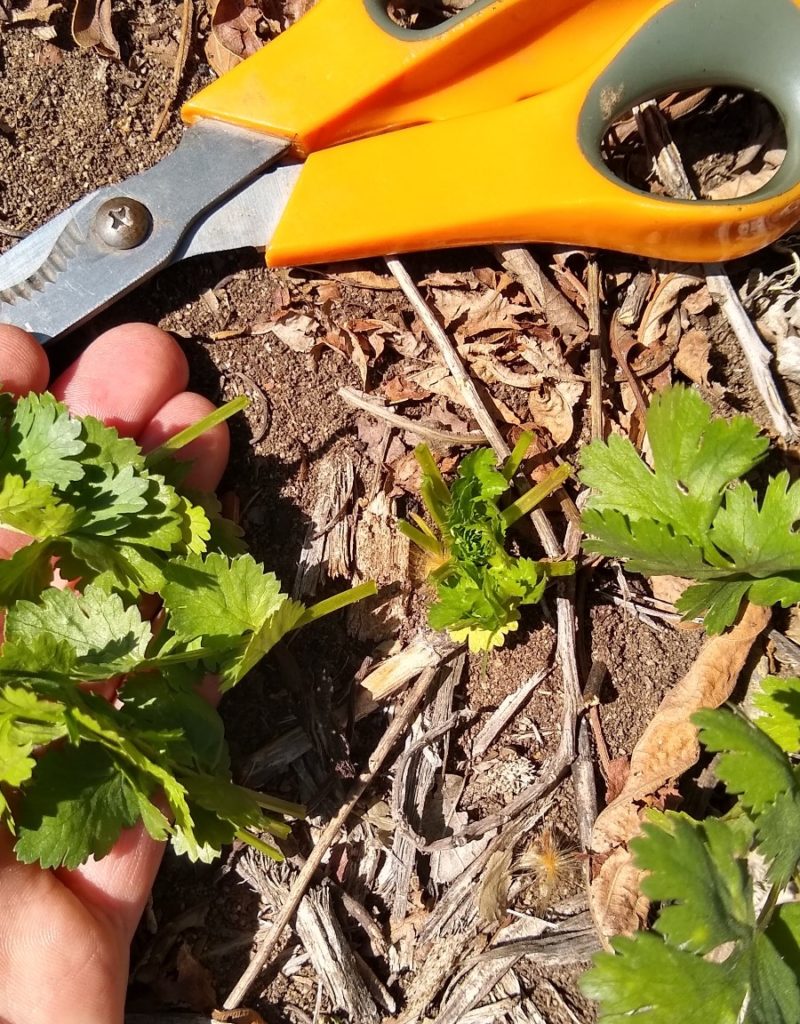
February here is not too late to easily sow some cilantro in your yard. We should get a few more rains in the next month or so, which could possibly sustain the plants through their entire lives. Buy some seeds and scatter them over mulch (that’s how I do it).
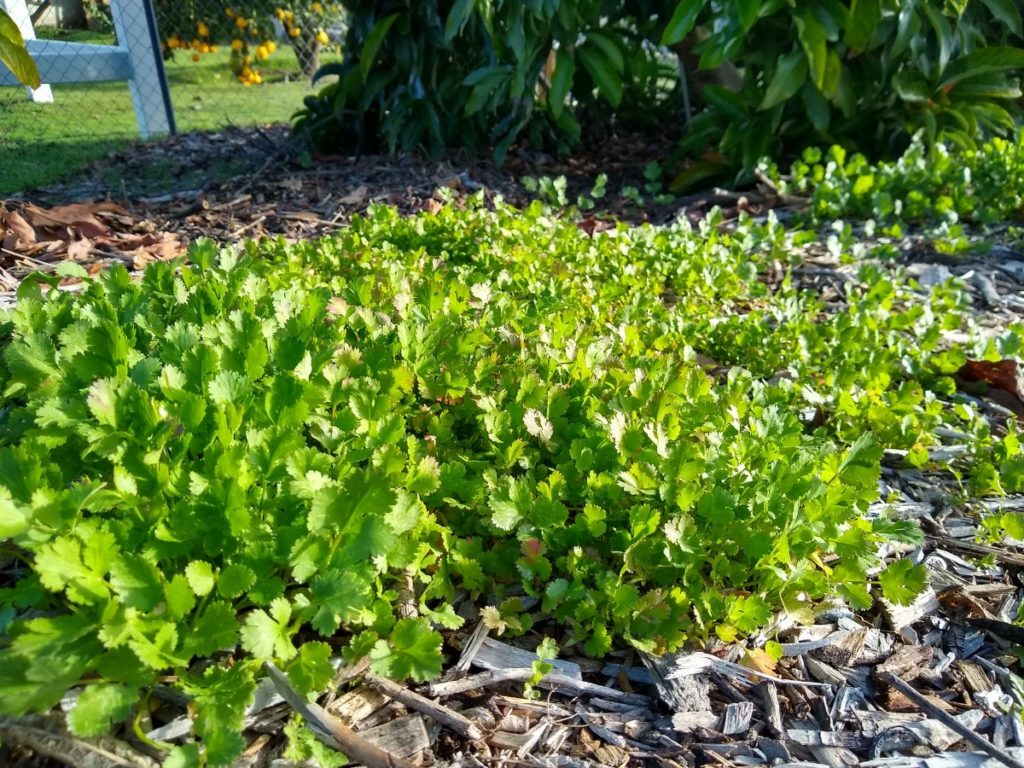
Or push the seeds into dirt about a quarter inch. Look for the plants to germinate a couple weeks after the next rain, or give them an earlier start with a single deep handwatering. Consider yourself warned, though, because after you see how naturally and easily they grow this time of year you might find yourself encouraging them to grow like weeds all over your yard.
A list of my Yard Posts is here.




Bit of info for anyone looking to buy avos. Went to Poway Walter Anderson on Monday 2/3 nice selection of #5 avos. I grabbed a Sharwil and a Carmen.
Okay I am going to go sprinkle some Cilantro seed right now!
Thank you for sharing about the Avos too. My Sharwill is loving coastal Dana Point! No leaf burn, it has exploded in 2 years time, the tree is gorgeous, but only 1 beautiful big Avocado so far. It is planted near a Hass, and a Reed. I think I will spray the flowers with diluted Honey this year and see if it will provide more fruit.
Hi Robin,
Please tell us how it goes if you do spray flowers with diluted honey. I’ve never gotten results from it, but I’m going to try on a few more trees this spring to see what happens.
Hi Frank,
Thanks for mentioning this. I’ve been meaning to do the same. Another uncommon and tasty avocado variety I saw there a week ago was Ettinger.
I should add that I was at Subtropica Nursery on February 6 and they had the following avocado trees: Sharwil, Carmen, Reed, Edranol, Hass, Julia, Hellen, Lamb, and Nabal — some on Zutano seedling rootstocks and others on various clonal rootstocks. Of note is that there were no GEM trees. They’re having a hard time keeping up with demand for that variety at the moment.
I’ve only room for two more (have 13, with 11 varieties), holding out for a JB or GEM, but unlikely to find them, and at my age, past 70, I’d like to be around to enjoy some fruit! But it’s still fun to watch the little guys GROW. THX again for all the wonderful posts!
There are some Gem avocado on Dusa trees for sale on Craigslist LA.
They were purchased from Subtropica Nursery a year ago
HD (Santee) just got in their avos, usual suspects, but 4 Ettingers from Durling, so grabbed one, as I had removed my 2 Fuerte babies, wanting a more reliable producer, and more upright tree.
Thanks for the cilantro info Greg . You are so right about the flowering decision they make.
I messaged the guy about the Gem so thanks for that tip. I killed two trees-sharwill and reed from root rot. Now I can’t plant the new trees in the same spot but they are the last 2 spots I can fit them in so hopefully a new tree will survive near the old hole. This time I’ll try planting on a mound and change water schedule.
Hi Bita,
If you can figure out any significant factors that encouraged the proliferation of root rot, you should be able to plant in the same spots. Many people have done this successfully. You’re right with planting on a mound, and you’re right to consider adjusting your watering. Adding coarse wood-chip mulch will also help. Best of luck!
Great post, thanks for the info! I never thought about the taproot making cilantro hard to transplant. I transplant cilantro with few problems but my transplants definitely waver for a bit.
I like to collect some of the fresh seeds to grind and use as seasoning in meals. It’s a wonderful flavor that I don’t encounter a lot.
Ha! I can’t stand cilantro, but my family loves it. I expect they would be really proud of me if I actually grew some for them.
Avacado question. We just bought a home in Fallbrook. I was really excited to start planting some avacado trees, but my 80-year-old neighbor who used to own an avacado grove said that because this land used to be an avacado grove that suffered root rot, I could never grow avacados here. Is that true? Thanks for your help!
Hi Shannon,
Make your family happy and grow some cilantro for them!
Your neighbor is probably mistaken, at least in part. While the fungus that causes the root rot disease is present in most avocado groves (current and former) throughout Southern California, according to a University of California farm advisor I’ve spoken to, there are effective methods of growing avocado trees in that soil nevertheless. Farmers and scientists around the world have been working on this issue for decades and they’ve really got it figured out.
Let me know if you’re going to plant, and I’ll advise on how to go about it with the best chance of success. The first thing you’ll want to consider is buying a tree on a rootstock that is known to be resistant to the root rot fungus. You can buy such trees right there in Fallbrook at Subtropica Nursery: https://www.subtropicanurseries.com/
Thank you so much!
My husband and I don’t like cilantro, much, but you sure make me want to grow some. You make everything sound so simple. LOL
On another note, I noticed the picture of cilantro growing near your 3 avocado trees, sunflower, and poppies, they look pretty skinny to me. Now mine is probably wider than 2 of your trees put together and is a good 15-16 ft. tall. We got a great crop this year, finally, after waiting a good 6 years for some. We got almost 70 avocados on the one tree. Normally we only get 3-4 but I was picking them too early. It’s a Bacon avocado. I learned to wait until early Dec. to start picking them. Some will also fall on their own which I love because they hide so well. I swear at least 20 were well hidden, I had no idea they were there. Anyway I make smoothies and put avocado in them. My neighbor also told me she freezes hers when they get ripe so they won’t spoil and when they thaw she uses them in her smoothies. So I’m going to try that this year. I have 4 in the freezer already. I’m sure they’ll be watery when they thaw but that won’t matter if mixed in a smoothie. With the price of avocados these days, I can’t see eating so many in order not to waste them. I do share with family and neighbors but I’m not giving these away now that I know they can be frozen. LOL I had sticker shock when I saw avocados at $2.50 at my local grocery store. So these are gold for us now. LOL I’ll let you know how they turn out frozen when I use them.
Thanks, Debbie! I used to freeze Bacon avocados too — just the flesh, not whole. They do look mushy and unappealing when they thaw, but the taste is all there. Perfect for smoothies, you’re right.
Do you grow asparagus? Not having any luck with veggies per se, absolute full sun all day on the area. I keep trying different shade tactics but…. tired of it. I thought perhaps I’d do better with asparagus as I actually eat it every day!
Hi Pamela,
I think you should plant some asparagus. I’ve been removing my asparagus bed over the last couple years because we don’t eat enough of it, but it is easy to grow and you only have to plant it once. Winter is the time to find bare root crowns and plant asparagus. Look for it at a nursery starting around Christmas time.
I love this encouragement, thank you. Waiting till winter will give me time to prepare the bed too.
Hi Greg,
We bought two of your wonderful calendars — one as a gift for our next door neighbor who loves to grow as well.
Do rabbits eat the cilantro? If so, I will have to cage or grow in our 3′ high raised Corten steel beds. I am going it there now and they are flourishing.
My neighbor wants to grow the avocado that doesn’t oxidize (name escapes me at the moment). He has killed two trees thus far. The area where he planted it is near a California pepper tree. I am thinking that may be the culprit?
I have shared your website with a few neighbors who have invested significantly, first with a well, second with in line drip and third, buying many 15 gallon fruit trees.
Thanks so much for all your advise and expertise.
Lorie
South Bonsall/sharing property lines with Cal-a-Vie
Hi Lorie,
I’ve never seen rabbits eat cilantro in my yard, and I grow a lot of it so I would think I would notice it. There are many avocado varieties that don’t brown much. It can certainly be a problem for an avocado tree to be planted near a large California pepper tree (or any other large tree); this is mostly because the large tree’s roots will suck up much of the water you give the little tree unless you are watering a broad area and in large volume. Thanks for the kind words and for sharing the calendar!